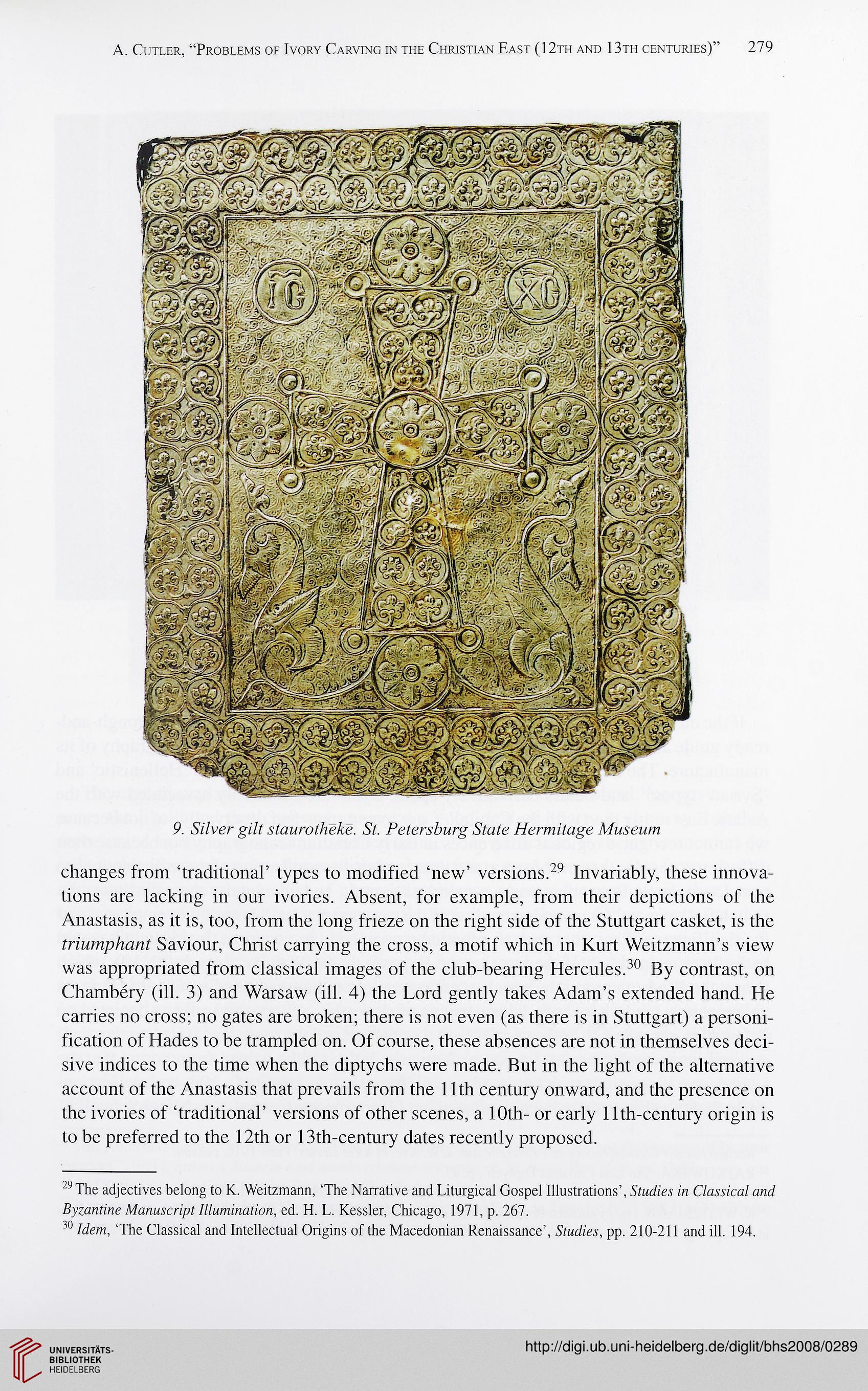A. CUTLER, "PROBLEMS OF IVORY CARVING IN THE CHRISTIAN EAST (12TH AND ) 3TH CENTURIES)" 279
9. 577ver gi/t via a rot A cłu. 57. Pcter.s/^ta^ ,S7a tc Marantagc A7a.saaa?
changes from 'traditional' types to modified 'new' versions.^ Invariably, these innova-
tions are lacking in our ivories. Absent, for example, from their depictions of the
Anastasis, as it is, too, from the long frieze on the right side of the Stuttgart casket, is the
Saviour, Christ carrying the cross, a motif which in Kurt Weitzmann's view
was appropriated from classical images of the club-bearing Hercules.^ By contrast, on
Chambéry (ill. 3) and Warsaw (ill. 4) the Lord gently takes Adam's extended hand. He
carries no cross; no gates are broken; there is not even (as there is in Stuttgart) a personi-
fication of Hades to be trampled on. Of course, these absences are not in themselves deci-
sive indices to the time when the diptychs were made. But in the light of the alternative
account of the Anastasis that prevails from the 11th century onward, and the presence on
the ivories of 'traditional' versions of other scenes, a 10th- or early 11th-century origin is
to be preferred to the 12th or 13th-century dates recently proposed.
^The adjectives belong to K. Weitzmann, 'The Narrative and Liturgicai Gospel Illustrations', AiMics hi Cinssicai anJ
ßyzanhnc Manuscript /tiunanahon, ed. H. L. Kessler, Chicago, 1971, p. 267.
^ /&nr, 'The Classical and Intellectual Origins of the Macedonian Renaissance', MiMics, pp. 210-211 and ill. 194.
9. 577ver gi/t via a rot A cłu. 57. Pcter.s/^ta^ ,S7a tc Marantagc A7a.saaa?
changes from 'traditional' types to modified 'new' versions.^ Invariably, these innova-
tions are lacking in our ivories. Absent, for example, from their depictions of the
Anastasis, as it is, too, from the long frieze on the right side of the Stuttgart casket, is the
Saviour, Christ carrying the cross, a motif which in Kurt Weitzmann's view
was appropriated from classical images of the club-bearing Hercules.^ By contrast, on
Chambéry (ill. 3) and Warsaw (ill. 4) the Lord gently takes Adam's extended hand. He
carries no cross; no gates are broken; there is not even (as there is in Stuttgart) a personi-
fication of Hades to be trampled on. Of course, these absences are not in themselves deci-
sive indices to the time when the diptychs were made. But in the light of the alternative
account of the Anastasis that prevails from the 11th century onward, and the presence on
the ivories of 'traditional' versions of other scenes, a 10th- or early 11th-century origin is
to be preferred to the 12th or 13th-century dates recently proposed.
^The adjectives belong to K. Weitzmann, 'The Narrative and Liturgicai Gospel Illustrations', AiMics hi Cinssicai anJ
ßyzanhnc Manuscript /tiunanahon, ed. H. L. Kessler, Chicago, 1971, p. 267.
^ /&nr, 'The Classical and Intellectual Origins of the Macedonian Renaissance', MiMics, pp. 210-211 and ill. 194.




